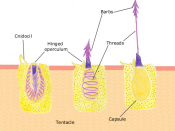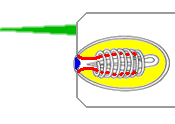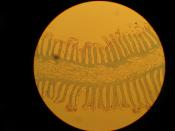The two phyla Cnidaria and Ctentophora makeup the radiate animals. Most radiates have tentacles or oral extensible projections around the oral end that are armed with cells that may function in defense and capture prey. The cells found within the tentacles are structurally and functionally unique to each phylum, such as the cindocytes in Cnidarians and colloblasts in Ctenophores.
Cnidarians capture prey with special stinging cells called cindocytes. These cells are found throughout the epidermis but are particularly abundant in the tentacles. Cnidocytes contain a cilium or modified cilium structure with a kinetosome at its base. This structure is known as the cnidocil and it receives a chemical as well as tactile stimulation.
The nematocyst is the actual stinging element. The undischarged nematocyst is a tiny capsule composed of a chitin-like material containing a coiled tubular filament that is continuous of the narrow end of the capsule.
Fig1 UNDISCHARGED NEMATOCYST
When the cnidocyte is stimulated to discharge, the nematocyst membrane becomes permeable to water, and the high internal osmotic pressure causes fluid to rush into the capsule.
The osmotic pressure falls rapidly, opening the operculum and increasing the hydrostatic pressure. The increased pressure everts the thread and drives the nematocyst from the cnidocyte. When the nematocyst is discharged, its cnidocyte is absorbed and a new one replaces it.
In the Hydra, there are three functional types of nematocysts. First, Pentrants, these are comprised of a tube that is open at the tip and usually armed with barbs and spines. When they are discharged, they penetrate the prey and inject poison. The open end of the 'thread' /filament may inject protein toxin that produces a sting.
FIG2 DISCHARGED NEMATOCYST
Second, some nematocysts function by entanglement such as the volvents. These cnidocytes have a tube that is closed at the end,


